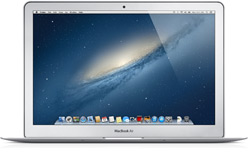

Gone is the Ethernet port (a Thunderbolt-to-Gigabit Ethernet adapter will be available in July 2012), audio line-in, and, most significantly, an optical drive. It appears the new connector is slimmer than its predecessor and incompatible with previous MagSafe adapters, but no other details were forthcoming if you’re hoping to use a regular MagSafe cable to power the new MacBook Pro, Apple is happy to sell you an adapter for $9.99.Īlso interesting is what’s missing. New to the line is an HDMI port, as well as dual microphones.Īn interesting change is a new MagSafe 2 connector for providing power (since when did power plugs get version numbers?). Ports of Call - The Retina display MacBook Pro includes two Thunderbolt ports and two USB 3.0 ports, a headphone port, and an SDXC memory card slot. The built-in battery can operate the machine for up to 7 hours, according to Apple, with 30 days of standby time before being depleted. (See “ Improve MacBook Pro Battery Life with gfxCardStatus,” 21 February 2011, for an explanation of how graphics switching works and to learn about a great utility for monitoring and controlling it.) The laptop automatically switches between the two modes depending on what’s required by running software. In terms of other processing power, both configurations include onboard Intel HD Graphics 4000 and discrete Nvidia GeForce GT 650M (1 GB of GDDR5 memory) graphics processors.
#2012 apple macbook pro retina specs upgrade
An upgrade to a 2.7 GHz processor is available on the high-end configuration for an extra $250. The MacBook Pro can either come with a 2.3 GHz or 2.6 GHz processor. The Retina display MacBook Pro models all sport a quad-core Intel Core i7 processor with 6 MB of shared 元 cache. It includes 8 GB of 1600 MHz DDR3L memory, configurable up to 16 GB, and either 256 GB or 512 GB of flash storage on the high-end configuration, that capacity can be bumped up to 768 GB (for an extra $500). Processors and Power - Apple is positioning this new laptop as more pro than the other Pros, with an all-flash storage architecture for improved speed. For example, most of the internal parts are designed by Apple, including fans with asymmetric blades that purportedly reduce noise while they’re pushing heat out of the machine. In the promotional video about the new MacBook Pro, Apple touts several unique design decisions. To compare, the other 15-inch MacBook Pro model is 0.95 inch (2.41 cm) thick and weighs 5.6 pounds (2.56 kg). However, it’s just 0.71 inch (1.8 cm) thick when closed, and it weighs 4.46 pounds (2.02 kg). The body of the Retina MacBook Pro resembles the rest of the MacBook Pro lineup, and it’s not tapered like the MacBook Air, as we expected. Apple also showed off improved versions of Aperture and Final Cut Pro X that take advantage of the new display.
#2012 apple macbook pro retina specs mac os x
Mac OS X Lion has been updated to handle the higher-resolution display, as have Mail, Safari, iMovie, and iPhoto (although those updates were not yet available at press time).

It uses in-plane switching (IPS) technology to provide a 178-degree field of view. Apple says the screen isn’t just higher resolution, but also higher quality, with deeper blacks, a 29 percent higher contrast ratio, and a 75-percent reduction in glare (while still being a glossy screen). To compare, the third-generation iPad’s Retina display includes over 3 million pixels, while the iPhone 4 and 4S boast 614,000 pixels. Retina and Design - The 15.4-inch Retina display features a resolution of 2880 by 1800 pixels at 220 pixels per inch, or more than 5 million pixels total.

Although the new specs are good news for some people, that announcement turned out to be a clever bit of misdirection for the more dramatic reveal: an all-new 15-inch MacBook Pro, featuring a slimmer body design, all-flash memory storage, and a Retina display - which Apple is cleverly calling the “ MacBook Pro with Retina Display.” (Yes, as with so many of Apple’s recent naming decisions, we hate the name, too.)


 0 kommentar(er)
0 kommentar(er)
